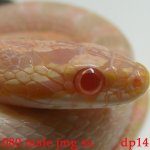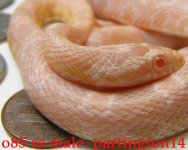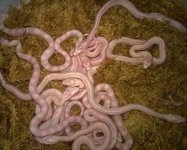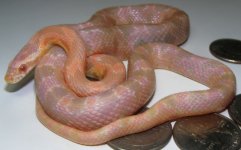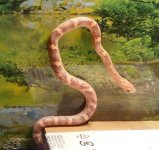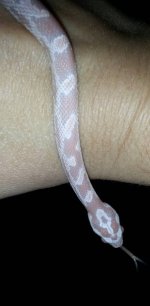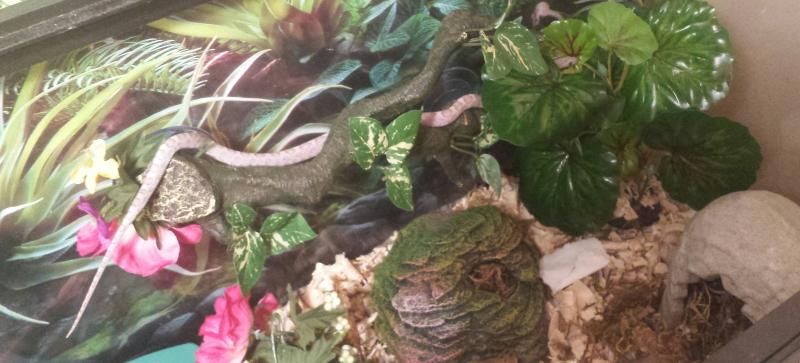-
Hello!
Either you have not registered on this site yet, or you are registered but have not logged in. In either case, you will not be able to use the full functionality of this site until you have registered, and then logged in after your registration has been approved.
Registration is FREE, so please register so you can participate instead of remaining a lurker....
Please be certain that the location field is correctly filled out when you register. All registrations that appear to be bogus will be rejected. Which means that if your location field does NOT match the actual location of your registration IP address, then your registration will be rejected.
Sorry about the strictness of this requirement, but it is necessary to block spammers and scammers at the door as much as possible.
You are using an out of date browser. It may not display this or other websites correctly.
You should upgrade or use an alternative browser.
You should upgrade or use an alternative browser.
The PINK Corn Snake Thread: Post Pictures of Your PINK Corns..... Regardless of Morph
- Thread starter wendhend
- Start date
MotleyMedusa7
lovin' my sweet corns
nice close up,Dave! 
here are my 2 salmon snow stripe keepers from last year,Loki & Pinkie Pie,they're still gaining pink with every shed --
--



here are my 2 salmon snow stripe keepers from last year,Loki & Pinkie Pie,they're still gaining pink with every shed



dave partington
Crazy Dave
albertagirl
Sharan
Dave, sorry to take you back a couple of pages, but what morph is that in picture number 2 from your May 8th post? I believe it was on page 11 that I saw it.
Thanks
Thanks
zorro
Old Guy
Hatching today. Coral Snow Tessies.
Those are awesome, we've got to talk!!!
John
dave partington
Crazy Dave
Dave, sorry to take you back a couple of pages, but what morph is that in picture number 2 from your May 8th post? I believe it was on page 11 that I saw it.
Thanks
Salmon Snow is the closest answer I can give you on that. In 2013 I mixed up a lot of SS from several different breeders and lineages.
post: http://www.cornsnakes.com/forums/showpost.php?p=1641499&postcount=105
That boy now lives in California.
albertagirl
Sharan
Salmon Snow is the closest answer I can give you on that. In 2013 I mixed up a lot of SS from several different breeders and lineages.
post: http://www.cornsnakes.com/forums/showpost.php?p=1641499&postcount=105
That boy now lives in California.
Thanks Dave! He's a beauty! And your coral tesseras? Um ya, want one!
I have a general question regarding pink coloration in corns, to anyone who has thoughts on the matter. Is it only the lavender gene, or all pink morphs in general that really show more color in males? I want a sweet pink corn, but a female, and I'm hearing that males really get pinker at least in the lavender morphs.
Gayle
New member
You just want my snake haha!! I see you have some lovely tessies!!Hadn't looked at this thread in awhile.
Gayle, let's get married!.
Got lucky with the camera today:
ravendance
New member
Hatching today. Coral Snow Tessies.
Another snake morph to add to the ever growing wishlist!! They look fantastic!!
ravendance
New member
I have a general question regarding pink coloration in corns, to anyone who has thoughts on the matter. Is it only the lavender gene, or all pink morphs in general that really show more color in males? I want a sweet pink corn, but a female, and I'm hearing that males really get pinker at least in the lavender morphs.
I'm interested in this as well...I've been told yes and no from several different sources...I think it also depends on the line the snake in question came from...right?
dave partington
Crazy Dave
Thanks Dave! He's a beauty! And your coral tesseras? Um ya, want one!
I have a general question regarding pink coloration in corns, to anyone who has thoughts on the matter. Is it only the lavender gene, or all pink morphs in general that really show more color in males? I want a sweet pink corn, but a female, and I'm hearing that males really get pinker at least in the lavender morphs.
Seems everyone is looking to tie the entire coral/salmon/pink snow cornsnake morphs down to being amel+anery base, +something else. There are ten thousand un-named Locality, that is, wild visual variations of corn snakes. Perhaps I am under-estimating. I remember well the time I was wrong.
Some genes SEEM ABLE TO BE (I am not saying that they are) split off in a few different directions, and then given names of their own. Bloodred/Diffused (now has two names), and that thick red coating that the oldschool original bloodreds carried. Those annoying white bellies the old school breeders had, they wanted those to go away, they wanted that wrap-around red coating to go all the way around on their bodies. Then someone fiddled with that white belly, and it began to creep up their sides. The Diffusion, the way the pattern on the sides. The base color: Heavy deep red color but not necessarily a lot of black melanin iridophores or whatever those color-holding-pores of skin are called. And if it has split belly checkers. Sheesh. I hate to drag Masque into this, carrying the "HEAD MARKER" as well. (bloodred? masque? etc. Nevermind the new gray/white headed bloodreds.
Surmise. Bloodred=
1 Bloodred
2 Masque? & split belly checkers
3 Pied
4 Red coating
5 Diffused
6 Whatever-the-name-is for the base color. I'm naming it Daveberry. There. I just created a gene, right before your eyes. Very eyes, that is. Like movie stars, right here on the interwebs.
It SEEMS that Bloodred has been chiseled away into all of these other components, parts of the bloodred gene are now considered several other genes. Where does it ever end? What if you could chisel away little bits and pieces of
all other gene names and traits and
Visual Components of the known Genes--
you, as each individual, are able to see move away in your own selective breedings.
Line breed for that specific particle of a gene,
since its a visual trait the first time you spot it
for 5 generations to refine, so that it behaves with Mendy's Punnet Box Predictability calculator
Now get busy in the corn kitchen & whip me up some neon rainbow snow!
Thanks for sharing-
dp
ps, a couple of random Thoughts:
next time you see any classic aka 'normal' snake, of any kind for that matter, and think of all of the different simple recessive genes, try to imagine how each of the colors you are looking at will translate to amel, or one of the aneries (caramel, charcoal, Anery A, lavender, silver-something 1, 2, &3 or whatever they're called, etc. The definition of anery is "no red"; therefore I left Cinder out). Sometimes, what my old eyes perceive to just be black on a wild-caught cornsnake, mixed with an anery, in the F1 proves out blue upon closer inspection. Also consider there are layers of skin, so if a heavy red layer of skin is on the outside of the scales, everything underlying may be blocked by that darker, light-wavelength absorbing--- layer of exo-color. There is still so much we do not know.
I don't usually post photos of dilute charcoal anery copper hypo lavender caramel masque ExtremeChipsOffManyGene holdback treasures, but when I do, it usually just means I don't often disclose everything inside pets on the available list. It's not really an issue to me. I don't breed for capturing specific genes, I breed for visual color. I know it's an issue for some, to be able to neatly and tidy-like compartmentalize every attribute, and if that's what someone needs, who am I to judge?
Attachments
germanshepherd
New member
germanshepherd
New member
whoops, meant to say HAS nice pink hue, not had..
rainbow_bright83
New member
NiklasTyreso
New member
Salmon Snow is the closest answer I can give you on that. In 2013 I mixed up a lot of SS from several different breeders and lineages.
Thats the way you breed great animals!
1) To get better offspring than the parents, you have to have to increase the genetic variability, not decrease genetic variability with linebreeding.
2) Selection of the best looking animals from different genetic lines is a must, as you do not want to increase genetic variability with poor looking animals.
HannaKonda
New member
Kevin S.
Active member
14 pages into a pink corn thread and no one has posted a specter yet? I leave for a year and just look what happens! Never fear, I have pictures to post here.
Juvenile specter I hatched (probably dripping with pink now as an adult):



Another specter, father of the juvenile above:


Salmon snow-he had a lot of different colors mixed in his palette, but definitely wasn't short on the pink.


An odd anery girl with a pinkish tint that didn't photograph well. Hopefully you can see a bit of it though.


Sold as a ghost, but she turned out to be an ultramel anery-this girl also had a pink wash.


Specter and ultramel anery together:

Juvenile specter I hatched (probably dripping with pink now as an adult):



Another specter, father of the juvenile above:


Salmon snow-he had a lot of different colors mixed in his palette, but definitely wasn't short on the pink.


An odd anery girl with a pinkish tint that didn't photograph well. Hopefully you can see a bit of it though.


Sold as a ghost, but she turned out to be an ultramel anery-this girl also had a pink wash.


Specter and ultramel anery together:

peaches987
Owner of Katsu
So much cute!! \^o^/
I want a Lavender some day.
I want a Lavender some day.
albertagirl
Sharan
That specter is super pretty! What is the morphology behind that? (I don't know if I just made that word morphology up, but I like it!)
albertagirl
Sharan
That specter is super pretty! What is the morphology behind that? (I don't know if I just made that word morphology up, but I like it!)
My apologies Kevin S. I see that you've already explained it in your other post.
"For those that don't know, specters are a line of unusual ghost corns that trace back to an unusual wild caught individual Kathy Love acquired in Naples, FL. They tend to have pink background coloration, though some don't (the non-pink individuals are sometimes referred to as banshees), and sometimes have yellow coloration in their dorsal saddles, but not always. Pattern aberrancies are also common in this line as well as thick black saddle borders. So there are a few interesting traits prevalent in this lineage, but they can be expressed independently of one another and their mode of inheritance is still uncertain. " ~ quoted from Kevin S.

